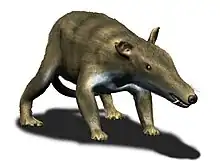| Sloanbaatar Temporal range: Late Cretaceous | |
|---|---|
| Scientific classification | |
| Domain: | Eukaryota |
| Kingdom: | Animalia |
| Phylum: | Chordata |
| Class: | Mammalia |
| Order: | †Multituberculata |
| Family: | †Sloanbaataridae |
| Genus: | †Sloanbaatar |
| Species: | †S. mirabillis |
| Binomial name | |
| †Sloanbaatar mirabillis Kielan-Jaworowska, 1970 | |
Sloanbaatar is a mammal genus that lived in Mongolia during the Upper Cretaceous. It lived at the same time as the dinosaurs. This animal was a member of the also extinct order Multituberculata within the suborder Cimolodonta and the family Sloanbaataridae.
The genus Sloanbaatar was named by Kielan-Jaworowska, Z. in 1970. The name means "Sloan's hero", in honour of paleontologist R.E. Sloan.
Fossil remains of the only known species, Sloanbaatar mirabillis, have been found in the Coniacian - Santonian (Upper Cretaceous)-age strata of the Djadokhta Formation in Mongolia.
References
- Kielan-Jaworowska (1970), "New Upper Cretaceous multituberculate genera from Bayn Dzak, Gobi Desert", Palaentologica Polonica 21, p.35-49.
- Kielan-Jaworowska, Z. & Hurum, J.H. (2001), "Phylogeny and Systematics of multituberculate mammals", Paleontology 44, p.389-429.
- Much of this information has been derived from Mesozoic Mammals: Djadochtatherioidea, an Internet directory.
This article is issued from Wikipedia. The text is licensed under Creative Commons - Attribution - Sharealike. Additional terms may apply for the media files.




